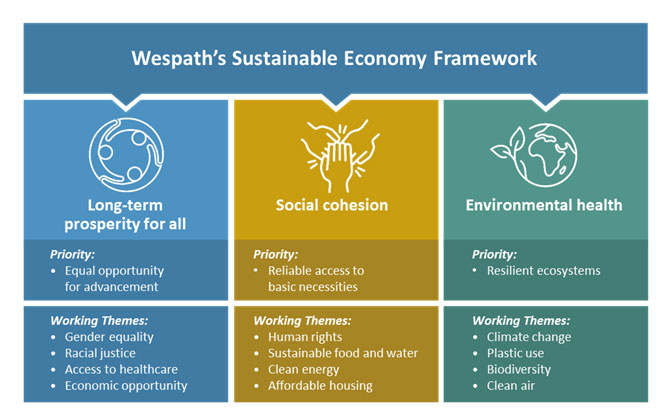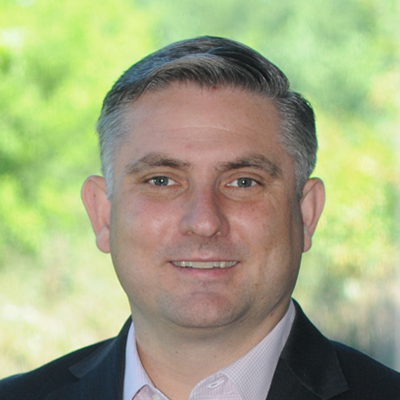Investment Insights Blog: Putting Our Sustainable Economy Framework into Practice
By Trent Sparrow
Manager, Impact Investments
Throughout our Investment Insights blog posts, we often reference our Sustainable Economy Framework (SEF). The SEF highlights our belief that investors working together can create and support an economy that delivers healthier financial markets, more resilient companies and greater financial security for Wespath’s benefit plan participants and institutional investors. This said, the question that I most often am asked is, “How is Wespath actually working to make a sustainable global economy a reality?” The goal of this blog is to peek behind the aspirational SEF curtain and provide some concrete examples of how we are working to accomplish the goals within our SEF.

Investing in Impactful Investment Opportunities
Wespath has a long history of impact investing or investing with the stated objective of strengthening local and global communities while also seeking to produce market rates of return. For example, since 1990, Wespath has invested over $2 billion in multifamily affordable housing through our Positive Social Purpose (PSP) Lending Program. These investments have led to the creation of over 52,000 housing units, created 65,000 jobs and generated more than $1.9 billion in tax revenues.1 We have invested in properties in all 50 U.S. states—find out if there is one in or near your community by searching our PSP property map.
Additionally, through the PSP Lending Program, we have invested over $83 million in small business loans to entrepreneurs in developing and emerging markets, so these individuals have a way to create or grow their businesses, strengthening their local communities and economies and improving their personal livelihoods.
On a broader level, we invest in low-carbon transition strategies—both in the U.S. and internationally—which seek to identify companies for investment that are well-prepared for the transition to a lower- carbon economy. For example, an investment in Developing World Markets (DWM) provided financing to institutions that help individuals in developing areas of the world purchase solar-powered lanterns, home solar kits and other products and services to light their homes, charge mobile devices, run their businesses, refrigerate their food and more.
These investments—along with others made in sustainable agribusiness and sustainable forestry—highlight how we can seek market-rate investment returns for our stakeholders, while contributing to a more sustainable global economy.
Engaging with Corporations to Address Environmental, Social and Governance (ESG) Risks
Shareholder engagement is at the heart of our sustainable investment activities. We believe engagement with corporations is a powerful process that adds long-term shareholder value. We scale our engagement efforts by also dialoguing with the asset managers in which we invest about how they incorporate ESG factors on our behalf.
An example of Wespath’s engagement as a shareholder is with Entegris, a major global provider of materials and components used in the technology manufacturing industry. We identified that the company lagged its peers regarding the diversity of its board of directors. We have long felt, and the research demonstrates,2 that diverse boards result in better company performance. After Entegris failed to satisfactorily respond to our request for dialogue about the lack of diversity, Wespath filed a shareholder resolution asking Entegris’s management to include diverse candidates in future director searches. Shortly after the resolution filing, Entegris agreed to meet and, as a result of that meeting, amended its board nominating policy to include language specifically stating that women and minority candidates would be included in future board of director searches. This example underscores Wespath’s ability to leverage its role as a shareholder to implement changes it believes will add long-term to the investments of its participants and institutional investors.
Management of Excessive Sustainability Risk
While we believe engagement with corporations is often the most powerful tool to enact positive change, we also acknowledge there are issues and/or corporate business practices that present excessively high levels of financial risk for investors. In these cases, we may avoid certain investments exposed to these risks. Wespath’s board of directors adopted a policy that we call our “Management of Excessive Sustainability Risk (MESR)” guidelines, focusing on two issues: climate change and human rights. As it relates to human rights, we exclude companies operating in countries demonstrating a pattern of human rights violations and in conflict-affected areas where significant human rights violations have been widely documented. We also exclude sovereign debt of any country demonstrating a prolonged and systematic pattern of human rights abuses. As it relates to climate change, we identify and exclude high-risk companies involved in the thermal coal industry. We strongly believe that these guidelines will lead to improved investment performance by addressing the investment risk created by investing in companies with unsustainable business policies and practices.
Bringing it All Together
The examples I discussed aren’t the only ways we are investing in alignment with a sustainable global economy; they are merely a snapshot of our sustainable investment activities. Investing sustainably enhances our ability to achieve our core fiduciary obligation to our participants and institutional clients. As Wespath Benefits and Investments’ CEO, Andy Hendren, so eloquently noted in one of his previous blogs, our approach is a “yes and” approach. Yes, we invest to maximize invest returns, and we do it in a sustainable manner. We believe investing in alignment with the SEF will be the tide that “raises all boats” for stakeholders and move the world toward a more sustainable future—one that our participants will want to retire into, and one that will more easily facilitate the missional work carried out by our institutional clients.
1 Estimate based on data obtained from the National Association of Home Builders 2016
2 CS Gender 3000, Credit Suisse Research, Sept. 2016

